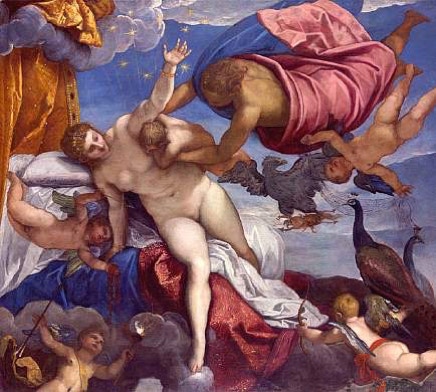
The Milky Way is not, of course, a constellation, but a band of faint light crossing the sky, consisting of countless distant stars. Aratus wrote of the sky being ‘cleft all around by a broad band’ which he called Γάλα (Gala, the Greek for milk). Eratosthenes called it Κύκλος Γαλαξίας (Kýklos Galaxías), the circle of milk. Ptolemy in the Almagest spelled the name γαλακτίας (galaktías).
The Roman writer Manilius compared the Milky Way to the luminous wake of a ship. Ovid in his Metamorphoses described it as a road lined on either side by the houses of distinguished gods – ‘the Palatine district of high heaven’, he termed it. Along this road the gods supposedly travelled to the palace of Zeus.
Eratosthenes tells us that the Milky Way was the result of a trick played by Zeus on his wife Hera so that she would suckle his illegitimate son Heracles and hence make him immortal. Hermes laid the infant Heracles at Hera’s breast while she was asleep, but when she woke and realized who the baby was – perhaps by the strength with which he sucked – she pushed him away and her milk squirted across the sky to form the Milky Way.
Tintoretto’s painting titled The Origin of the Milky Way illustrates the myth of the baby Heracles being placed at the breast of Hera, with her milk spilling out to form the Milky Way. However, unlike in the traditional version recounted by Eratosthenes, it seems that here it is not Hermes but Zeus himself who is placing the baby at Hera’s breast, for in the background we see his eagle carrying a thunderbolt, as well as the peacocks of Juno. ( Photo © The National Gallery, London.)
Manilius listed various explanations for the Milky Way that were current in his day, both scientific and mythological. One suggestion was that it is the seam where the two halves of the heavens are joined – or, conversely, where the two halves are coming apart like a split in the ceiling, letting in light from beyond. Alternatively, said Manilius, it might be a former path of the Sun, now covered in ash where the sky was scorched. Some thought that it could mark the route taken by Phaethon when he careered across the sky in the chariot of the Sun god, Helios, setting the sky on fire (see Eridanus). Yet again, noted Manilius, it could be a mass of faint stars, an idea attributed to the Greek philosopher Democritus of the fifth century BC, which we now know to be correct. Finally, on a quasi-religious note, Manilius suggested that the Milky Way could be the abode of the souls of heroes who had ascended to heaven.
A common Arabic term for the Milky Way was darb al-tabbānah, the path of straws, conjuring up a picture of farmers dropping a trail of straws as they returned from the fields. To the Arabs of the Middle Ages the Milky Way was known as al-majarra, from a word meaning a place where something is pulled or drawn along, such as a cart track. It seems that Arabic scientists such as al-Bīrūnī (973–1048) understood the Milky Way’s true nature as a distant mass of stars long before the advent of the telescope.
Chinese associations
In Chinese astronomy, the Milky Way was Tianhe, the Celestial River, also translatable as River of Heaven. Nine stars in Cygnus, including Deneb, represented Tianjin, a ford across the river at a point where it appeared to be particularly shallow; the impression of shallowness comes about because a dark cloud of dust in the local spiral arm of our Galaxy called the Great Rift obscures part of the Milky Way in this region.
© Ian Ridpath. All rights reserved



